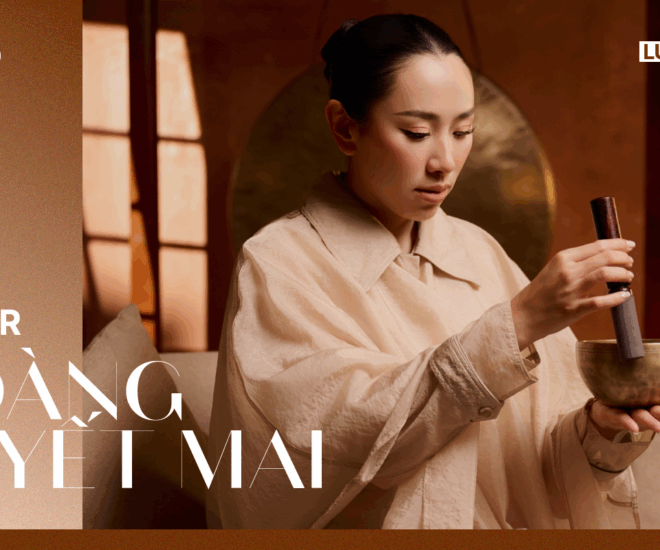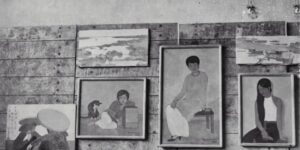Đánh tráo Trần Tấn Lộc: mười năm một lỗi hệ thống
Bài báo này được xuất bản bằng ba ngôn ngữ Việt, Pháp và Anh. Cet article est publié en trois langues : vietnamien, français et anglais. This article is published in three languages: Vietnamese, French and English.
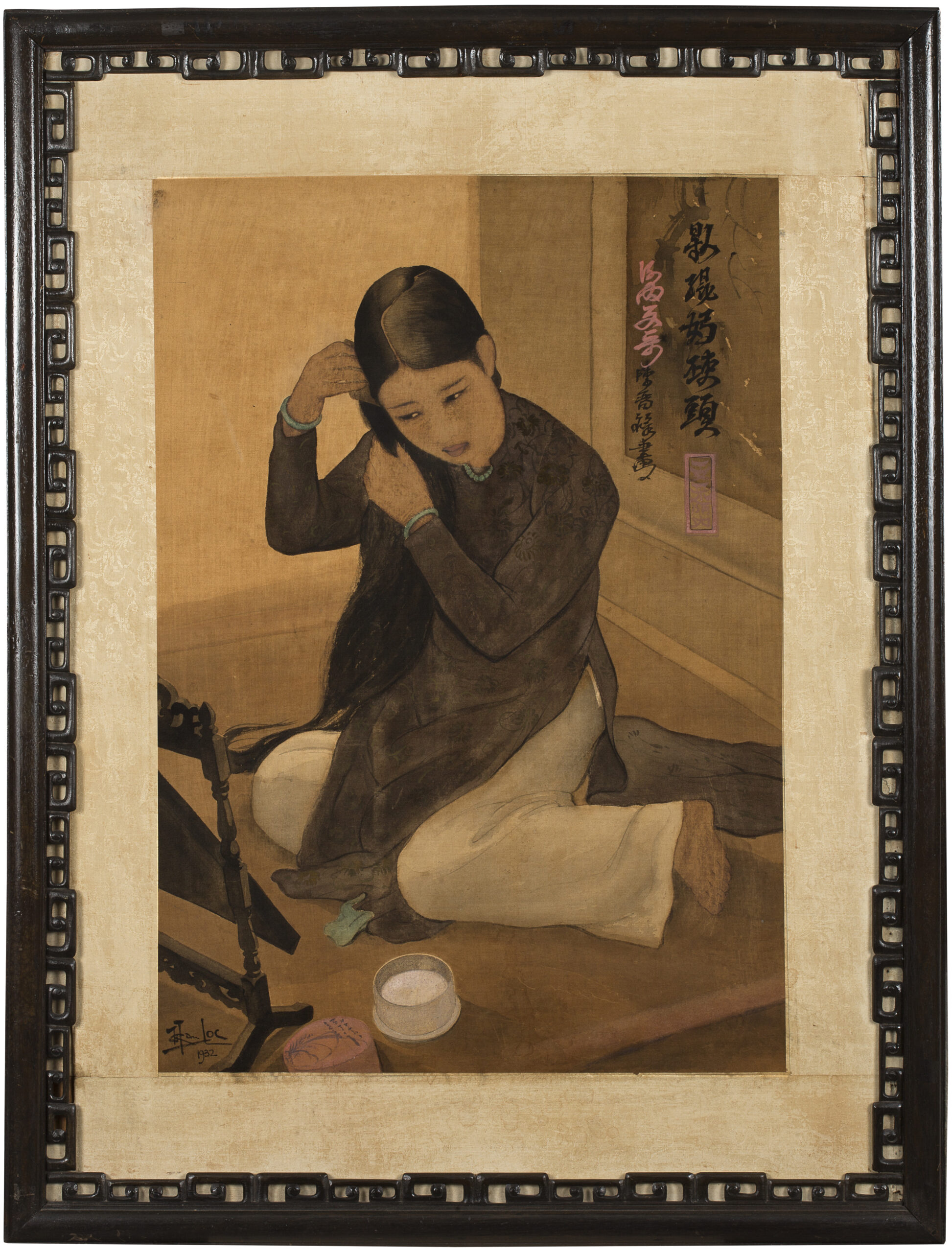
“Thiếu nữ chải đầu” (1932) sẽ được nhà Aguttes đưa ra trong phiên đấu giá ngày 14.03.2022 – Phiên đấu giá lần thứ 32 “Các họa sĩ châu Á – Tác phẩm nghệ thuật lớn”. Mức giá dự kiến từ 80,000 đến 120,000 EUR. Nguồn: aguttes.com
Mấy ngày qua, cộng đồng yêu nghệ thuật Đông Dương dậy sóng vì một “nghi án lịch sử” đã được phơi bày ra ánh sáng, mà công thuộc về nhà nghiên cứu Kevin Vuong.
Trong phiên đấu sắp tới ngày 14.03.2022 của nhà Aguttes, bức tranh được “chọn mặt gửi vàng” lên bìa cuốn catalogue – nói cách khác, là vị trí được kỳ vọng tăng giá nhất, với sự tự tin cao nhất về tính xác thực, được ghi là “Thiếu nữ chải đầu” (1932) của danh họa Trần Bình Lộc, cựu thủ khoa trường Cao đẳng Mỹ thuật Đông Dương (EBAI), với mức giá dự kiến 80,000 – 120,000 EUR. Theo lịch sử đấu tại một nhà lớn như Aguttes, con số gõ búa sẽ thường cao hơn gấp 2 – 4 lần.
Tuy nhiên, chỉ cần nhìn thoáng qua chữ ký tiếng Latin, ta có thể thấy rõ ràng đây không phải là chữ ký Trần Bình Lộc, mà là của một họa sĩ khác có tên Trần Tấn Lộc. Trần Tấn Lộc (1906 – 1968) là ai? Rất ít người biết tới, và Kevin Vương đã bỏ công lần ra manh mối, trò chuyện với gia đình, bạn bè, đồng nghiệp để có bài viết vén màn cho danh tính này.
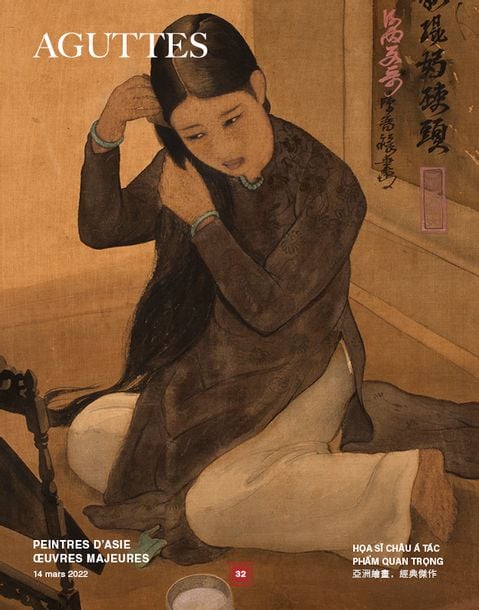
Bức tranh “Thiếu nữ chải đầu” (1932) của Trần Tấn Lộc đang được nhà Aguttes cho là của Trần Bình Lộc và chọn làm bìa catalogue tháng 3 năm 2022.
Trong khuôn khổ bài viết này, tôi sẽ không đi sâu vào tiểu sử Trần Tấn Lộc, mà muốn phân tích một lỗi hệ thống quan trọng để đặt ra câu hỏi về khả năng nghiên cứu, cùng động cơ của các nhà đấu giá phương Tây khi làm việc với tranh Việt.
Qua những trao đổi với nhóm đồng nghiệp nghiên cứu của tôi, nhà Aguttes đã rất tự tin khẳng định “Thiếu nữ chải đầu” (1932) là của Trần Bình Lộc là do một số lý do sau đây:
Thứ nhất, nhà Aguttes dựa theo chữ ký tranh và công bố thẩm định của 4 nhà đấu giá trước đó:
– Lô đấu ngày 09.12.2020 tại nhà Thierry de Maigret, gõ búa 3,091 EUR
– Lô đấu ngày 03.11.2020 tại nhà Asium, gõ búa 1,310 EUR
– Lô đấu ngày 24.01.2017 tại nhà Lynda Trouvé.
– Lô đấu ngày 04.10.2010 theo thông tin Mutual Art.
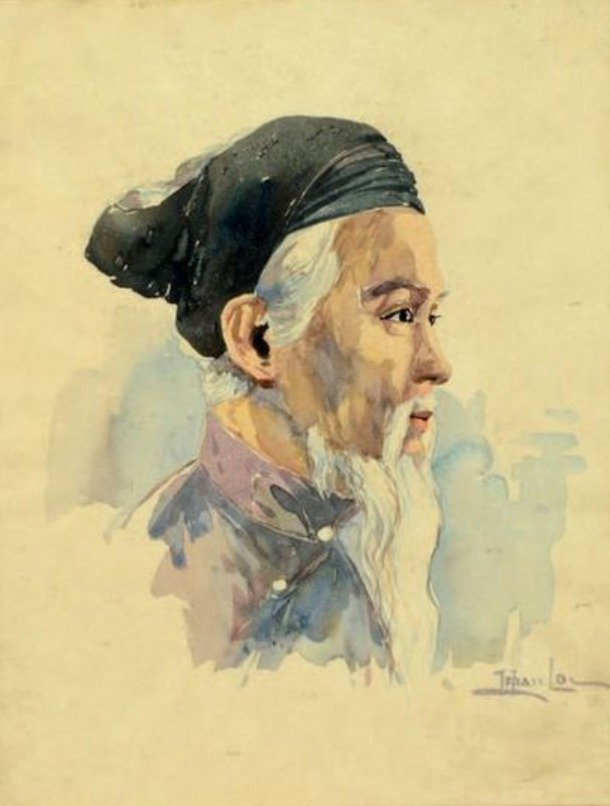
Lô đấu ngày 09.12.2020 tại nhà Thierry de Maigret gõ búa 3,091 EUR. Chữ ký “Tr Tan Loc”. Nguồn: lotsearch.net/lot/tran-binh-loc

Lô đấu ngày 03.11.2020 tại nhà Asium gõ búa 1,310 EUR. Chữ ký “Tr Tan Loc”. Nguồn: asium-auction.com

Lô đấu ngày 24.01.2017 tại nhà Lynda Trouvé. Chữ ký “Tr Tan Loc”. Nguồn: auction.fr/_en/lot/tran-binh-loc
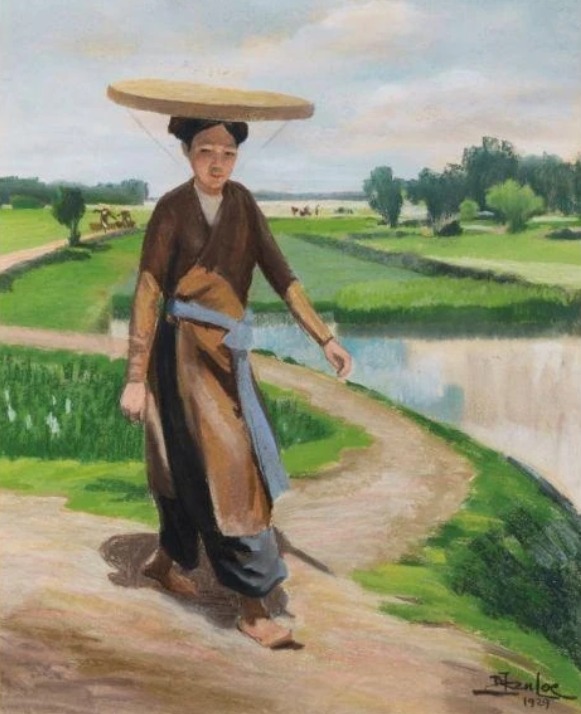
Lô đấu ngày 04.10.2010 theo thông tin Mutual Art. Chữ ký “Tr Tan Loc”. Nguồn: mutualart.com
Qua quan sát mắt thường, ta có thể thấy cả 4 lô đấu này đều có chữ ký “Tr Tan Loc”, không thể nhầm sang Trần Bình Lộc được. Hơn nữa, bức tranh đấu năm 2010 vẽ năm 1929, nếu là của Trần Bình Lộc (1914 – 1941) thật, thì lẽ nào cụ vẽ bức này lúc 15 tuổi, trước khi vào học EBAI? Như vậy đây là một lỗi hệ thống trải dài suốt một thập kỷ của toàn bộ các nhà đấu giá kể trên.
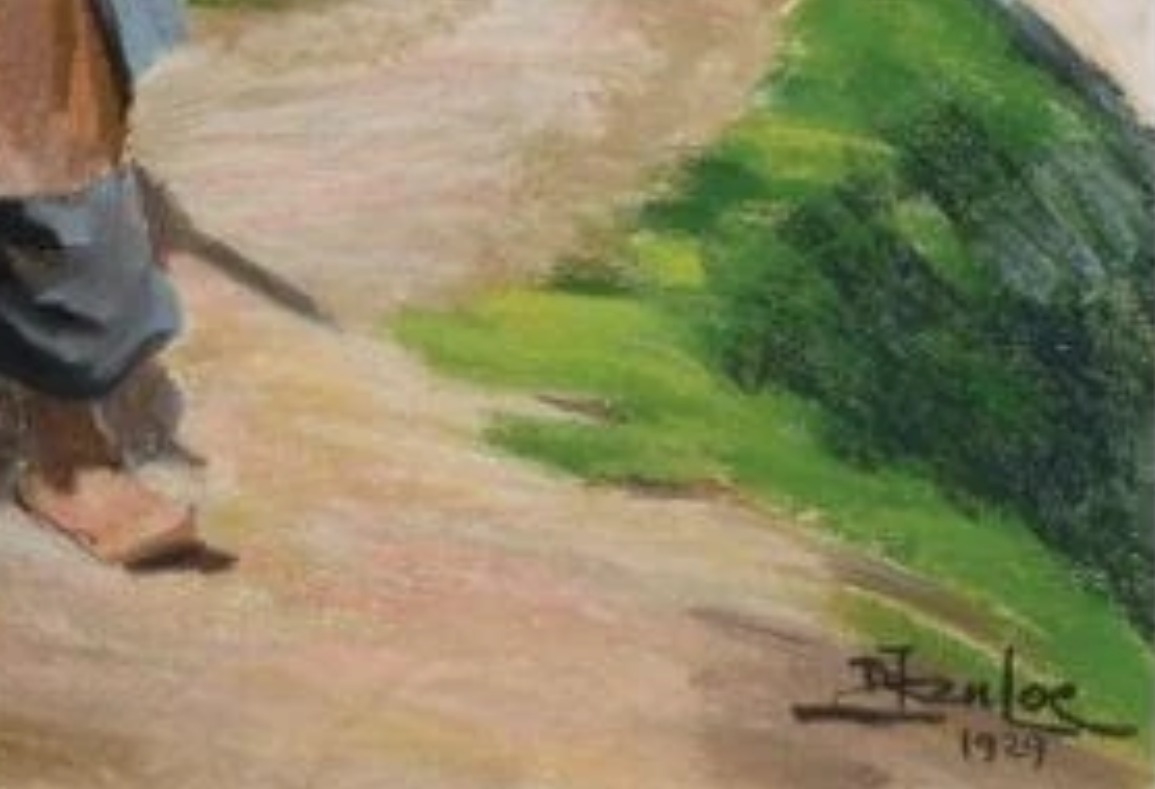
Ảnh chữ ký của Trần Tấn Lộc, chi tiết của bức “A Young Tonkinese on the Way to the Market” (1929)

Ảnh chữ ký của Trần Tấn Lộc, chi tiết của bức “Cô gái chải đầu” (1932)
Thứ hai, nhà Aguttes dựa vào một video clip của Art Online Gallery, có đăng một số bức tranh trong các lô đã đấu kể trên. Tuy nhiên, đây không nên được coi là nguồn tin cậy, vì nó chỉ đơn thuần tổng hợp các kết quả đấu giá, không có công tác thẩm tra lại. Đó là lỗi chồng lỗi.
Thứ ba, nhà Aguttes đã thông qua chuyên gia tiếng Trung trong đội ngũ của mình để đọc chữ ký họa sỹ và lạc khoản, để đưa đến kết luận “Cô gái chải đầu” là của Trần Bình Lộc. Và đây là lỗi quan trọng nhất, bởi chữ viết trên tác phẩm là chữ Nôm, trong khi các chuyên gia tiếng Trung chỉ đọc được chữ Hán.

Ảnh chi tiết của bức “Cô gái chải đầu” (1932)
Theo sự tư vấn của dịch giả Hán-Nôm Châu Hải Đường, lạc khoản chữ Nôm trên bức “Cô gái chải đầu” là “Trần Tấn Lộc hoạ” (vẽ bởi Trần Tấn Lộc), biên thêm tựa đề “Người con gái trải đầu” (“trải” ở đây tức là “chải”), chữ hồng viết theo lối hành thảo là “Hà Nội Văn Thái”, còn chữ hồng trong hình như dấu triện thì là “Văn Thái Hà Nội”, tức hoạ quán Văn Thái nơi cụ công tác ở Hà Nội.
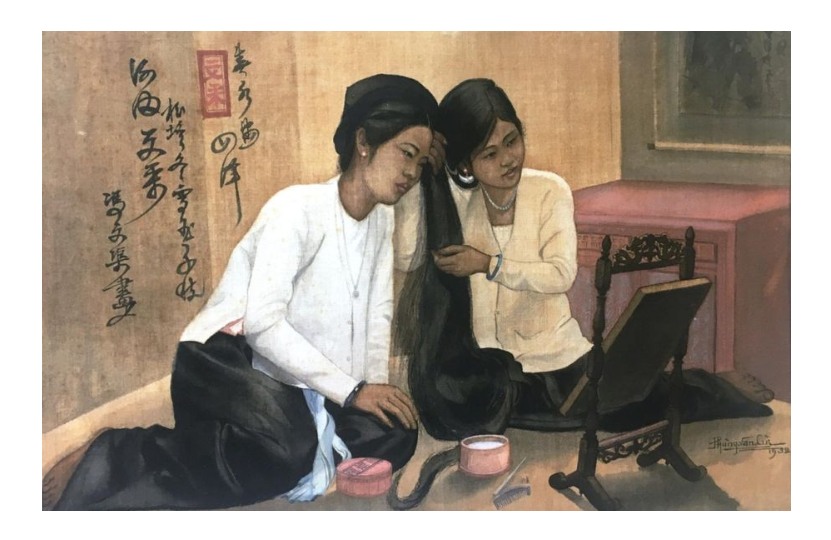
Bức tranh “Hai thiếu nữ chải tóc dài” (1932) của Phùng Văn Cừ. Nguồn: boisgirard-antonini.com
Để cho chắc chắn, chúng tôi so sánh thêm một bức với chủ đề tương tự, “Hai thiếu nữ chải tóc dài” (1932) của Phùng Văn Cừ đấu ngày 18.12.2020 tại nhà Boisgirard Antonini – ở đây nhà đấu giá cũng viết nhầm tên tác giả thành “Phung Van Cun”. Cũng theo dịch giả Châu Hải Đường, lạc khoản ở bức này đề “Phùng Văn Cừ họa”, với dòng thơ “Tùng lăng đông tuyết ngọc thiên chi” (“Thông vươn giữa tuyết mùa đông, ngàn cành như ngọc”), chữ mực đen có một dòng ghi “Hà Nội Văn Thái”, và chữ hồng trong hình như dấu triện cũng mang danh chương “Văn Thái”. Với phong cách thư pháp của lạc khoản hai bức giống nhau, chúng tôi đồ rằng cả hai bức đều được bán bởi hoạ quán Văn Thái, là đơn vị biên các lời bạt vào tranh năm 1932, và ghi chú tên họa sỹ lên đó. Đây là một phát hiện rất quan trọng.
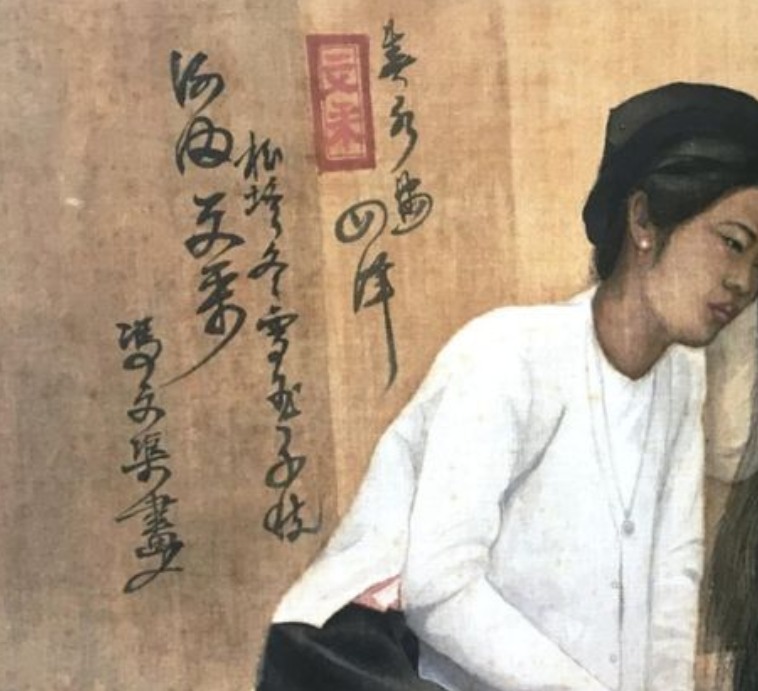
Chi tiết bức tranh “Hai thiếu nữ chải tóc dài” (1932) của Phùng Văn Cừ.
Như vậy để kết luận, loạt tranh được một loạt nhà đấu giá cho là của Trần Bình Lộc suốt một thập kỷ qua, thực chất là của họa sĩ Trần Tấn Lộc. Và qua vụ việc này, chúng tôi xin đặt ra câu hỏi về a) khả năng nghiên cứu văn hóa và lịch sử mỹ thuật Việt Nam của các nhà đấu giá kể trên; b) động cơ vẫn bảo lưu nhận định là tranh Trần Bình Lộc khi nghi vấn được nêu lên.
Thay mặt cho cộng đồng nghiên cứu và khán giả nghệ thuật Đông Dương, chúng tôi có một số yêu cầu như sau:
– Thứ nhất, các nhà đấu giá ở trên có động thái đính chính lại tranh, nhằm trả lại công bằng cho họa sĩ Trần Tấn Lộc.
– Thứ hai, về mặt lâu dài, các nhà đấu giá nên tìm đến tư vấn chuyên môn của các chuyên gia văn hóa, lịch sử mỹ thuật người Việt, nhất là những trường hợp liên quan đến chữ Nôm. Chuyên gia từ Trung Quốc sẽ không đọc được chữ Nôm.
Cộng đồng nghiên cứu luôn muốn đóng góp mang tính xây dựng, nhằm củng cố lại thị trường mỹ thuật đã vướng quá nhiều nghi vấn về tính xác tín. Hy vọng các nhà đấu giá sẽ cầu thị, mau chóng giải quyết trường hợp này.
Xin cảm ơn,
Ace Lê
(28.02.2022)
***
PHẢN HỒI TỪ ASIUM VỀ TRƯỜNG HỢP TRẦN TẤN LỘC
Chiều ngày 28.02.2022, tức là nửa ngày sau khi tôi đăng bài viết về vụ việc họa sỹ Trần Tấn Lộc bị định danh nhầm thành Trần Bình Lộc suốt 10 năm trên các sàn đấu giá, đã có phản hồi chính thức đầu tiên từ một trong số các nhà đấu giá được đề cập trong bài viết.
Cụ thể, đại diện từ nhà đấu giá Asium, đã liên lạc với chúng tôi để thừa nhận nhầm lẫn trong việc định danh họa sỹ tại lô 145 trong phiên ngày 03.11.2020, và ngay lập tức đã đính chính thông tin lô đấu này trên website chính thức.
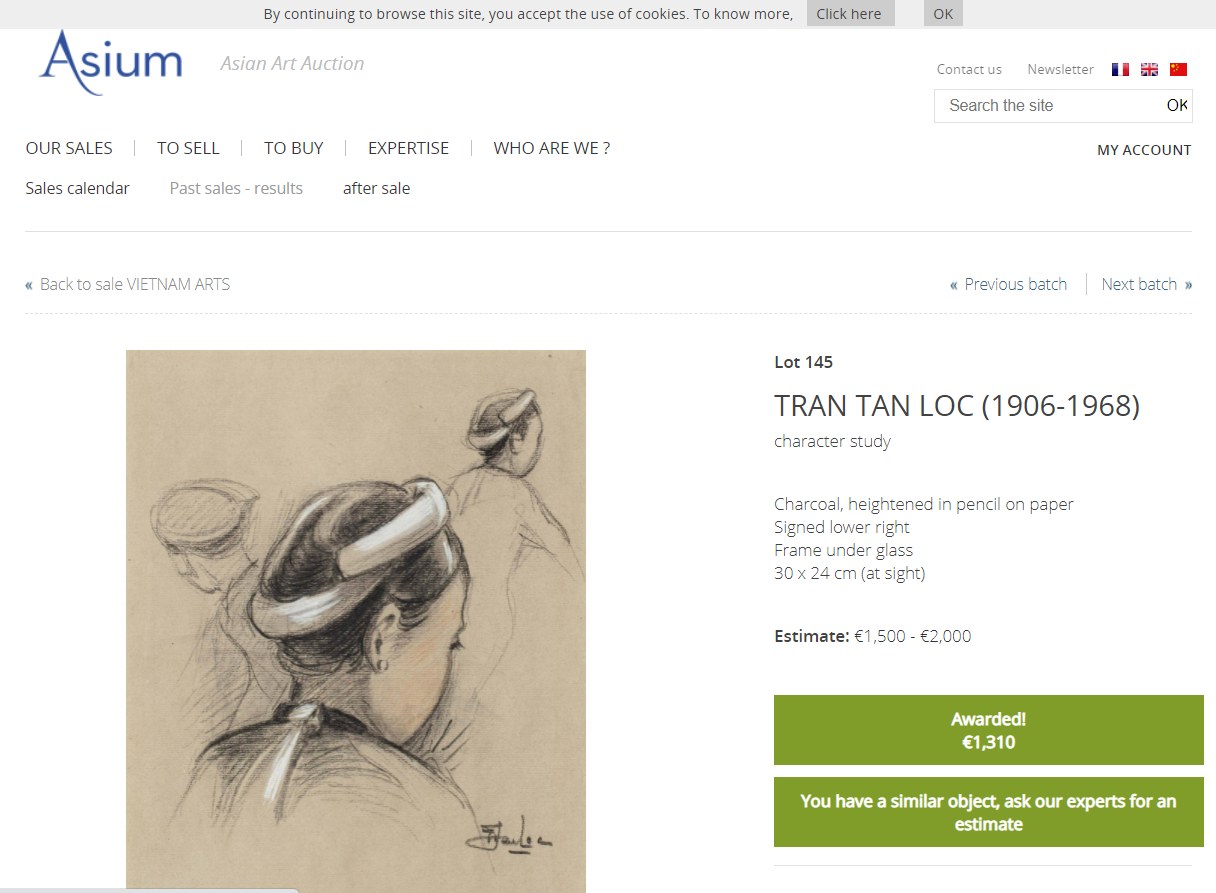
Trang web của Asium nay đã cập nhật về định danh chính tác của tác giả Trần Tấn Lộc.
Đây là một động thái cầu thị và minh bạch, rất đáng hoan nghênh.
Xin thay mặt cộng đồng yêu nghệ thuật, cảm ơn sự phản hồi nhanh chóng từ Asium.
Trân trọng,
Ace Lê
(28.02.2022)
===
L’ERREUR D’IDENTIFICATION DE TRẦN TẤN LỘC : UNE ERREUR SYSTÉMIQUE SE PERPÉTUANT DEPUIS UNE LONGUE DÉCENNIE
(En Français traduit par Anne Ng)

Le tableau « Jeune élégante se coiffant » (1932) sera proposé par la maison Aguttes lors de la vente aux enchères du 14 mars 2022 – Dans le cadre de la 32ème séance de la vente aux enchères « Peintres d’Asie – Œuvres majeures ». Gamme de prix prévue de 80.000 à 120.000 EUR. Source : aguttes.com
Au cours de la semaine dernière, la communauté artistique vietnamienne s’est réjouie de résoudre l’un des mystères de longue date de l’histoire de l’art indochinois, résolution dont le crédit majeur va au chercheur en histoire de l’art Kevin Vuong.
Lors de la prochaine vente du 14 mars 2022 de la maison Aguttes, l’œuvre en couverture du catalogue est « Jeune élégante se coiffant » (1932) attribuée par la maison Aguttes au maître Trần Bình Lộc de l’École des Beaux-Arts d’Indochine (EBAI), estimée de 80 000 à 120 000 EUR.
Cependant, un simple coup d’œil à la signature en vietnamien jette immédiatement le doute : il est clair qu’il ne s’agit pas là de la signature du peintre Trần Bình Lộc, mais de celle d’un autre peintre nommé Trần Tấn Lộc. Qui est Trần Tấn Lộc ? Il existe peu d’informations publiques sur ce peintre. Après des recherches assidues pour trouver et contacter les membres survivants de sa famille, les collègues et les amis du peintre, Kevin Vương est finalement arrivé à dévoiler avec succès une biographie tardive appropriée de Trần Tấn Lộc.

« Jeune élégante se coiffant » (1932), Trần Tấn Lộc, l’œuvre en couverture du catalogue de la maison Aguttes mars 2022.
Dans cet article, je ne me focalise pas sur le profil du peintre, mais je soulignerai une erreur systémique qui court depuis plus de dix ans et qui appelle à une plus grande expertise locale de l’histoire de l’art Indochinois dans la plupart des maisons de ventes étrangères.
En réponse aux préoccupations de mes collègues concernant l’identification erronée de « Jeune élégante se coiffant », la maison Aguttes avance les preuves suivantes à l’appui de son attribution du tableau à Trần Bình Lộc :
Tout d’abord, la maison Aguttes cite la signature du peintre et la cohérence avec les œuvres précédemment attribuées à Trần Bình Lộc par quatre autres maisons de ventes :
– Un lot le 9 décembre 2020 par Thierry de Maigret, martelé à 3.091 EUR.
– Un lot le 3 novembre 2020 par Asium, martelé à 1.310 EUR.
– Un lot le 24 janvier 2017 par Lynda Trouvé.
– Un lot le 4 octobre 2010 selon les informations de Mutual Art.

Un lot le 9 décembre 2020 par Thierry de Maigret, martelé à 3.091EUR. Source: lotsearch.net/lot/tran-binh-loc

Un lot le 03 novembre 2020 par Asium, martelé à 1.310EUR avec la signature “Tr Tan Loc”. Source: asium-auction.com

Un lot le 24 janvier 2017 par Lynda Trouvé avec la signature “Tr Tan Loc”. Source: auction.fr/_en/lot/tran-binh-loc

Un lot le 04 octobre 2010 selon les informations de Mutual Art avec la signature “Tr Tan Loc”. Source: mutualart.com
En observant simplement à l’œil nu, nous avons pu voir que ces quatre lots portent la signature claire de “Tr Tan Loc” – qui ne peut être confondue avec le peintre Trần Bình Lộc. De plus, comme pour le lot de 2010, le tableau est daté de 1929, suggérant que Trần Bình Lộc (1914-1941) l’aurait peint alors qu’il n’avait alors que 15 ans (!). Cela pourrait être considéré comme une erreur systémique produisant un effet domino, basé sur un précédent, sur plus d’une décennie par toutes les maisons de vente aux enchères mentionnées ci-dessus.

La signature de Trần Tấn Lộc. Un détail du tableau « Une jeune Tonkinoise en route pour le marché » (1929).

La signature de Trần Tấn Lộc. Un détail du tableau « Jeune élégante se coiffant » (1932)
Deuxièmement, la maison Aguttes cite une vidéo de Art Online Gallery qui comprend un certain nombre de tableaux dans les lots susmentionnés. Ceci n’est pas une source crédible, car il s’agit d’une simple compilation de résultats d’enchères, sans vérification appropriée. Les sources remontent à celles du premier point.
Enfin, la maison Aguttes cite son expert chinois interne concernant la lecture de la signature et des mots du tableau et conclu que « Jeune élégante se coiffant » est attribuable à Trần Bình Lộc. C’est l’omission la plus grave, car les caractères du tableau sont des Nôm vietnamiens (sino-vietnamiens) et non des Hán chinois (chinois classique).

L’image détaillée du tableau « Jeune élégante se coiffant » (1932)
Mes collègues et moi nous sommes ensuite tournés vers le traducteur professionnel et érudit Hán-Nôm Châu Hải Đường pour obtenir ses conseils. Selon lui, les mots Nôm se lisent clairement « Trần Tấn Lộc họa » (c’est-à-dire « Peint par Trần Tấn Lộc »), avec un titre « Người con gái trải/chải đầu » (« La fille se peignant ses cheveux »), et les lettres rouges écrites dans le style du sceau sont “Van Thai”, faisant allusion à l’atelier de peinture nommé Van Thai où Trần Tấn Lộc travaillait à Hanoï.

« Deux jeunes femmes peignant leurs longs cheveux » (1932) de Phùng Văn Cừ
Pour être doublement sûr, nous avons comparé ce tableau avec un autre du même thème et de la même période, « Deux jeunes femmes peignant leurs longs cheveux » (1932) de Phùng Văn Cừ, inclus dans la vente du 18 décembre 2020 par Boisgirard Antonini. Ici, la maison de vente aux enchères a également mal épelé le nom du peintre comme “Phung Van Cun”. Selon Châu Hải Đường, les mots de cette œuvre se lisent “Phùng Văn Cừ họa” (“Peint par Phùng Văn Cừ”), avec la ligne poétique “Tùng lăng đông tuyết ngọc thiên chi” (“Percer la neige de l’hiver, mille pins, les branches ressemblent à du jade »), et la lettre à l’encre noire a une ligne qui énonce “Hanoï Văn Thái”, et la lettre rose dans l’image comme un sceau similaire épelant également “Văn Thái”. Le style de calligraphie des deux tableaux, similaire, nous incite à conclure qu’effectivement les deux peintures ont été vendues par la même galerie Văn Thái à Hanoï, qui a compilé les postfaces des tableaux, inscrit le nom du peintre et les commentaires poétiques sur les travaux achevés en 1932. C’est une découverte très importante.

Extrait de « Deux jeunes femmes peignant leurs longs cheveux » (1932) de Phùng Văn Cừ
Pour conclure, toute la série de travaux attribuées à Trần Bình Lộc par les différentes maisons de ventes aux enchères au cours de la dernière décennie appartient à Trần Tấn Lộc. Cela appelle une réflexion approfondie sur a) l’expertise de l’histoire et de la culture de l’art vietnamien sur le marché de l’art étranger en général ; et b) le motif, le cas échéant, de continuer à insister sur l’erreur d’identification lorsque l’affaire est déjà éclaircie.
Au nom de la communauté des chercheurs et amateurs d’art d’Indochine, nous avons donc la volonté de formuler deux requêtes :
– Premièrement, que les maisons de vente aux enchères susmentionnées corrigent les lots actuels et passés pour les porter au crédit légitime du peintre Trần Tấn Lộc.
– Deuxièmement, à plus long terme, que les maisons de vente étrangères continuent de solliciter les conseils des historiens de l’art et des chercheurs vietnamiens, en particulier ceux qui peuvent fournir leur expertise sur le vietnamien et la langue Nôm. Les experts du chinois ne peuvent pas interpréter correctement les caractères Nôm, car il s’agit là d’une écriture à la construction bien distincte de l’écriture de la langue chinoise.
Nous espérons que les maisons de ventes aux enchères seront ouvertes à nos commentaires et critiques constructifs. Nous pourrions ensemble renforcer la création d’un marché de l’art indochinois sain et crédible.
Avec mes remerciements,
Ace Lê
(28.02.2022)
***
RETOUR D’ASIUM SUR LE CAS DE TRAN TAN LOC
Cet après-midi, le 28 février 2022, une demi-journée après que j’ai publié un article sur le cas où le peintre Tran Tan Loc a été identifié par erreur comme étant Tran Binh Loc pendant 10 ans dans des maisons de vente aux enchères, il y a eu une première réaction officielle de l’une des maisons de ventes mentionnées dans l’article.
Concrètement, un représentant de la maison de ventes aux enchères Asium nous a contacté pour admettre l’identification erronée sur le peintre Tran Tan Loc au lot 145 lors de la séance du 3 novembre 2020, et a immédiatement corrigé cette information de lot sur le site officiel.

Le site web d’Asium a maintenant été mis à jour avec l’identification réelle du peintre Trần Tấn Lộc.
Il s’agit d’une décision commerciale et transparente très bienvenue.
Au nom de la communauté des amateurs d’art, merci pour cette réponse rapide d’Asium.
Cordialement,
Ace Lê
(28.02.2022)
===
THE MISIDENTIFICATION OF TRẦN TẤN LỘC: A DECADE-LONG SYSTEMIC ERROR
(In English, written by Ace Lê)

“Jeune élégante se coiffant” (1932) will be auctioned by the Aguttes at the sale on 14.03.2022 – The 32nd Auction “Asian Painters – Great Artwork”. Expected price range from 80,000 to 120,000 EUR. Source: aguttes.com
Over the last week, the Vietnamese art community has rejoiced in solving one of the longstanding mysteries in our Indochine art history, with the foremost credits attributed to art researcher Kevin Vuong.
In the upcoming sale on 14.03.2022 by Aguttes, the catalogue-cover work is “Jeune élégante se coiffant” (1932) attributed to the master Trần Bình Lộc from École des Beaux-Arts de l’Indochine (EBAI), with the estimate of 80,000 – 120,000EUR.
However, a mere glance at the signature spells instant doubt: this is not a work by Trần Bình Lộc, but another artist named Trần Tấn Lộc. There is little public information on this artist. Upon insightful research to trace and reach out to the artist’s surviving family members, colleagues and friends, Kevin Vương finally arrived at, and successfully unveiled a proper, overdue biography for Trần Tấn Lộc.

“Jeune élégante se coiffant” (1932) by Tran Tan Loc is being titled to Tran Binh Loc by the Aguttes auction house and chosen as the cover of the March 2022 catalog.
In this post, I will not focus on the artist’s profile, but highlight a systemic error that has existed for over ten years – one that calls for better local expertise in Indochine art history in most foreign auction houses.
In addressing my colleagues’ concerns regarding the misidentification of “Jeune élégante se coiffant”, Aguttes cited the following evidence before concluding that it was a work by Trần Bình Lộc:
Firstly, Aguttes cited the artist’s signature to be consistent with the works previously attributed to Trần Bình Lộc by 04 other auction houses:
– A lot on 09.12.2020 by Thierry de Maigret, hammered at 3,091 EUR
– A lot on 03.11.2020 by Asium, hammered at 1,310 EUR
– A lot on 24.01.2017 by Lynda Trouvé.
– A lot on 04.10.2010 according to Mutual Art.

A lot on 09.12.2020 by Thierry de Maigret, hammered at 3,091 EUR, signature of “Tr Tan Loc”. Source: lotsearch.net/lot/tran-binh-loc

A lot on 03.11.2020 by Asium, hammered at 1,310 EUR, signature of “Tr Tan Loc”. Source: asium-auction.com

A lot on 24.01.2017 by Lynda Trouvé, signature of “Tr Tan Loc”. Source: auction.fr/_en/lot/tran-binh-loc

A lot on 04.10.2010 according to Mutual Art, signature of “Tr Tan Loc”. Source: mutualart.com
Just via visual inspection, we could see that all of these lots bear the clear signature of “Tr Tan Loc” – which could not have been mistaken for Trần Bình Lộc. Moreover, as for the 2010 lot, the work is dated 1929 – suggesting that Trần Bình Lộc (1914-1941) painted this when he was only 15 (!). This could be considered a systemic error with a domino effect, one based off the previous, over a period of 10 years.

The signature of Trần Tấn Lộc. Details of “A Young Tonkinese on the Way to the Market” (1929).

The signature of Trần Tấn Lộc. Details of “Jeune élégante se coiffant” (1932)
Secondly, Aguttes cited a video clip by Art Online Gallery that includes a number of works in the aforementioned lots. This is not a credible source, since it is a mere compilation of such without proper verification. The sources go back to those in the first point.
Lastly, Aguttes cited their in-house Chinese expert’s reading of the words in the artwork. This is the most severe oversight, for the characters in the painting are Vietnamese Nôm (Sino-Vietnamese) not Chinese Hán (classical Chinese).

Details of “Jeune élégante se coiffant” (1932)
My colleagues and I then turned to Hán-Nôm scholar and professional translator Châu Hải Đường for advice. According to him, the Nôm words clearly read “Trần Tấn Lộc họa” (“Painted by Trần Tấn Lộc”), with a title “Người con gái trải/chải đầu” (“A maid combing hair”), and the letters in the red mock-seal spelling “Văn Thái”, referring to the picture gallery named “Văn Thái” where he worked at in Hanoi.

“Deux jeunes femmes peignant leurs longs cheveux” (1932) by Phùng Văn Cừ. Source: boisgirard-antonini.com
To be doubly sure, we compared this work with another of the same theme and period, “Deux jeunes femmes peignant leurs longs cheveux” (1932) by Phùng Văn Cừ, included in the 18.12.2020 sale by Boisgirard Antonini. Here the auction house wrongly spelled the artist’s name as “Phung Van Cun” [8]. According to Châu Hải Đường, the words in this artwork read “Phùng Văn Cừ họa” (“Painted by Phùng Văn Cừ”), with the poetic line “Tùng lăng đông tuyết ngọc thiên chi” (“Piercing winter snow, a thousand pine branches look like jade”), with a black line reading “Hà Nội Văn Thái”, and a similar seal also spelling “Văn Thái”. The calligraphy style in both artworks is similar, prompting us to conclude that indeed both pictures were sold in the same Văn Thái gallery in Hanoi, which took the liberty to draw the artist’s credit, artwork title and poetry comments onto the finished works in 1932. This is an important finding.

Details of “Deux jeunes femmes peignant leurs longs cheveux” (1932) by Phùng Văn Cừ.
To conclude, the entire series of works attributed to Trần Bình Lộc by various auction houses over the last decade indeed belong to Trần Tấn Lộc instead. This calls for thorough reflection on a) the expertise on Vietnamese art history and culture among the foreign art market in general; and b) the motive, if any, to continue to insist on the misidentification when the case is already cleared.
On behalf of the Indochine art research and art lover community, we hence kindly put forth two requests:
– Firstly, for the aforementioned auction houses to correct the current and past lots to rightfully credit the artist Trần Tấn Lộc.
– Secondly, in the long run, for foreign auction houses to continue to seek advice from Vietnamese art historians and researchers, especially those who could lend their expertise on Vietnamese and the Nôm language. Experts in Chinese would not be able to read Nôm correctly, since it is an entirely different construct.
We hope that the auction houses would be open to constructive criticism. We could together strive to architect a healthy and credible Indochine marketplace.
With thanks,
Ace Lê
(28.02.2022)
***
OFFICIAL RESPONSE FROM ASIUM
As of today, 28.02.2022, 7 hours after I launched by Facebook post “The Misidentification of Trần Tấn Lộc”, the first among the involved auction houses has issued an official response regarding the matter. Specifically, a representative from Asium has swiftly reached out to us and confirmed their error in Lot 145 in the sale dated 03.11.2020, and immediately rectified it by correcting the artist’s name from “Trần Bình Lộc” to “Trần Tấn Lộc”.

Asium’s website has now been updated with the identity of the author Tran Tan Loc.
This is a constructive and transparent response on Asium’s part, which we highly appreciate.
On behalf of the Vietnamese art community, we thank Asium for their swift action.
Regards,


